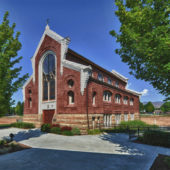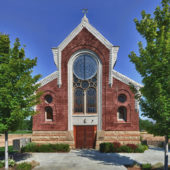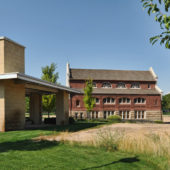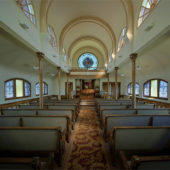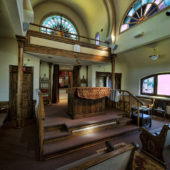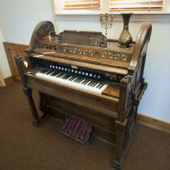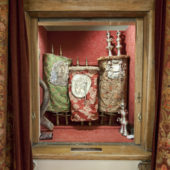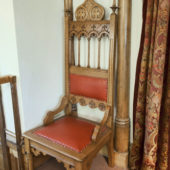The building is thought to be the oldest synagogue building in continuous use in the United States west of the Mississippi River.
Boise, Idaho’s Jewish community began in the 1860s, in the early mining camps. As Boise became settled, Jews began meeting in homes to celebrate the High Holidays. In 1895, twenty-five residents joined together to establish Congregation Beth Israel. The building that houses the congregation today has been in continuous use since 1896. It is considered the oldest synagogue west of the Mississippi River. The man who pioneered its construction later became mayor of the city and then governor of the state. Most of the congregants were from central Europe and they practiced the Reformed ritual.
These early congregants were merchants of staples and potatoes who generally prospered and were quickly integrated into local life. In 1912, several Jewish families, also immigrants from Eastern Europe, joined together and founded the Orthodox synagogue, Congregation Ahavath Israel. In the summer of 1986, the two congregations joined as one, establishing Ahavath Beth Israel, which is a Reformed synagogue. The congregation is comprised of approximately 210 families, has a full time Rabbi and is the center for Judaism in Idaho.
The synagogue’s wood-shingled building, constructed in 1896, blends two architectural styles popular with turn-of-the-century Jewish congregations. Designed by St. Louis architects Chestney & Schroeder the building seats 150 people. The exterior is predominantly designed in the popular Rundbogenstil style, although the tall windows flanking the large, rose windows are in the form of horseshoe arches, characteristic of Moorish design. Hundreds of wood shingles protect the exterior, which are laid in patterns to imitate stonework. The Moorish Revival detail continues inside, where the barrel-vaulted ceiling is supported by Moorish inspired horseshoe arches. The walls are adorned with pastel stained glass windows and the interior was designed with electric lights; a novelty at the time. The old organ is said to have been carried overland by horse drawn wagon from San Francisco.
In 1972 Ahavath Beth Israel was added to the National Register of Historic Places; this allowed the congregation to apply for a federal grant for renovation, which was completed in 1982. By 1994 the congregation had grown to approximately 120 families and was able to hire its first full-time rabbi, Daniel Fink. The congregation was outgrowing this historic building, without room to expand on the original site. Therefore, in 1998, the congregation voted to move the building to a new location with land upon which they could build needed additions to the old building. In 2003 the building was moved from its original location on State Street to its present location on Latah Street. During the move, documentation was discovered showing the original construction was partially financed by Marshall Field and Levi Strauss & Co.
Synagogue Ahavath Beth Israel’s “mission statement” is that it is a “progressive synagogue dedicated to Torah (lifelong learning), Avodah (spiritual growth), G’milut Chasadim (acts of lovingkindness) and Kehilah (community-building).

